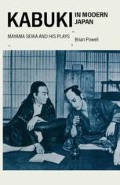Abstract
Yoritomo no Shi, with its implied repudiation of former attacks on Mayama’s historicity and its employment of kabuki techniques to highlight a single character’s inner anguish, marks both the end of one stage and the beginning of another in Mayama Seika’s career. For eight years, since Genboku to Chōei, Mayama had explored the dramatic possibilities of inner conflict with a number of different actors and in several different dramatic genres. The next few years do not see any diminution in the variety of plays written and produced or the types of production, but Mayama Seika now experiments more with subject matter. Most of the plays discussed in previous chapters have portrayed characters torn within themselves; several of those about to be discussed are known as representative Mayama Seika plays without having this characteristic.
Access this chapter
Tax calculation will be finalised at checkout
Purchases are for personal use only
Preview
Unable to display preview. Download preview PDF.
Notes
Matsumoto Kappei, Nihon Shingeki-shi (Chikuma Shobō, 1966) p. 4.
Kawatake Shigetoshi, Nihon Engeki Zens hi (Iwanami Shoten, 1959) p. 914.
Toita Kōji, Engeki Gojūnen (Jiji Tsūshinsha, 1956) pp. 192–3.
See B. Powell, ‘Communist kabuki: a contradiction in terms?’, in J. Redmond (ed.), Themes in Drama, vol. 1 ( Cambridge: Cambridge University Press, 1978 ) pp. 147–67.
Odagiri Susumu and Nihon Kindai Bungakkan (eds.), Kindai Nihon Bungaku Daijiten vol. iii (Kōdansha, 1977) p. 62.
Quoted in Ozaki Hideki and Tada Michitarō, Taishū Bungaku no Kanōsei (Kawade Shobō, 1971), p. 75.
D. Keene, Dawn to the West: Poetry, Drama, Criticism ( New York: Henry Holt, 1987 ) p. 434.
Morita Kan’ya, ‘Jōzu na netsu no aru hito’, Engei Gahō, xix.4 (April 1931) 56–8.
Atsumi Seitarō, ‘Okuni Kabuki Hyōban’, Engei Gahō, xxi.4 (April 1933) 38.
Abe Yutaka, ‘Tōgeki no yoru no bu’, Engei Gahō, xxi.11 (November 1933) 30–1.
Iwaya Shin’ichi, ‘Enshutsu Nijūgonen’, Engekikai, xi.7 (July 1953) 86.
Haramachi Tōnosuke, ‘Shōgun Edo o saru’, Engei Gahō, xxii.2 (February 1934) 37.
Ohira Noniji, ‘Edojō Sōzeme no inshō’, Engei Gahō, xiv.12 (December 1926) 61.
Atsumi Seitarō, ‘Shōgatsu no tōgeki o mita ato no taiwa’, Engei Gahō, xxii.2 (February 1934) 29.
Tanabe Akio, ‘Seika no seiji-higeki ni tsuite’, Kessakusen Mayama Seika-shū, vol. iii (Hokuyōsha, 1979) p. 340.
Copyright information
© 1990 Brian Powell
About this chapter
Cite this chapter
Powell, B. (1990). Experimentation. In: Kabuki in Modern Japan. St Antony’s. Palgrave Macmillan, London. https://doi.org/10.1007/978-1-349-20945-3_6
Download citation
DOI: https://doi.org/10.1007/978-1-349-20945-3_6
Publisher Name: Palgrave Macmillan, London
Print ISBN: 978-1-349-20947-7
Online ISBN: 978-1-349-20945-3
eBook Packages: Palgrave History CollectionHistory (R0)

